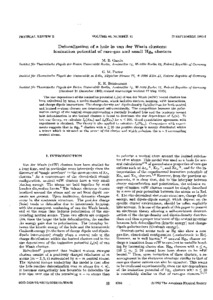Delocalization of a hole in van der Waals clusters: Ionization potential of rare-gas and small Hg_n clusters
| dc.date.accessioned | 2008-06-23T07:37:08Z | |
| dc.date.available | 2008-06-23T07:37:08Z | |
| dc.date.issued | 1993 | |
| dc.identifier.issn | 1098-0121 | |
| dc.identifier.issn | 0163-1829 | |
| dc.identifier.issn | 0556-2805 | |
| dc.identifier.uri | urn:nbn:de:hebis:34-2008062322157 | |
| dc.identifier.uri | http://hdl.handle.net/123456789/2008062322157 | |
| dc.format.extent | 890968 bytes | |
| dc.format.mimetype | application/pdf | |
| dc.language.iso | eng | |
| dc.publisher | American Physical Society | eng |
| dc.rights | Urheberrechtlich geschützt | |
| dc.rights.uri | https://rightsstatements.org/page/InC/1.0/ | |
| dc.subject.ddc | 530 | |
| dc.title | Delocalization of a hole in van der Waals clusters: Ionization potential of rare-gas and small Hg_n clusters | eng |
| dc.type | Aufsatz | |
| dcterms.abstract | The size dependence of the ionization potential I_p(n) of van der Waals (vdW) bound clusters has been calculated by using a model Hamiltonian, which includes electron hopping, vdW interactions, and charge-dipole interactions. The charge-density and dipole-density distributions for both neutral and ionized n-atom clusters are determined self-consistently. The competition between the polarization energy of the neutral atoms surrounding a partially localized hole and the tendency toward hole delocalization in the ionized clusters is found to dominate the size dependence of I_p(n). To test our theory, we culculate I_p(Xe_n) and I_p(Kr_n) for n \le 300. Good quantitative agreement with experiment is obtained. The theory is also applied to calculate I_p(Hg_n). Comparison with experiments suggests that in Hg_n^+ clusters with n \le 20 the positive charge is mainly distributed within a trimer which is situated at the center of the cluster and which polarizes the n - 3 surrounding neutral atoms. | eng |
| dcterms.accessRights | open access | |
| dcterms.bibliographicCitation | Phys. Rev. B 48, 8388 (1993) | |
| dcterms.creator | Garcia, Martin E. | |
| dcterms.creator | Pastor, G. M. | |
| dcterms.creator | Bennemann, K. H. | |
| dc.description.et | Extern | ger |
Dateien zu dieser Ressource
Das Dokument erscheint in:
-
Publikationen [18]

